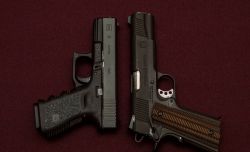 The infamous “Colt” 1911 and the Glock pistols represent the epoch debate over two classic diametrically opposed handgun designs. Like vanilla and chocolate ice cream there are diehard followers of each flavor as well as for each of these pistols. One can argue this model is better than the other, but it is a debate that will never produce a resolution much like the classic 9mm vs .45 ACP debate.
The infamous “Colt” 1911 and the Glock pistols represent the epoch debate over two classic diametrically opposed handgun designs. Like vanilla and chocolate ice cream there are diehard followers of each flavor as well as for each of these pistols. One can argue this model is better than the other, but it is a debate that will never produce a resolution much like the classic 9mm vs .45 ACP debate.
By Dr. John J. Woods, a contributing author to Survival Cache & SHTFBlog
The Battle of the Semi-Autos
 Everybody has their own personal preferences in nearly every aspect of life from cars to television shows to blue jeans to best hamburgers. That is I suppose in America the “spice of life” they talk about, because freedom as brought us so many choices. Truth is though there are many other choices than these two, but I chose these because I know them well, they are popular, proven designs that are readily available. Either would make a good survival support firearm.
Everybody has their own personal preferences in nearly every aspect of life from cars to television shows to blue jeans to best hamburgers. That is I suppose in America the “spice of life” they talk about, because freedom as brought us so many choices. Truth is though there are many other choices than these two, but I chose these because I know them well, they are popular, proven designs that are readily available. Either would make a good survival support firearm.
What Every Prepper Wants?
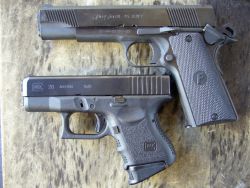 From the perspective of the prepper, I constantly get inquiries about which heavy duty semi-auto pistol to choose for SHTF scenarios, Bug In and Out self-defense, property patrol and the whole nine yards as it were. Pistols seem to dominate the discussion over wheel guns, but for me, those handguns are still a viable option for many. However, the marketplace and many survival blog sites are replete with advice on selecting a semi-auto and for good reasons. Therefore, newbies and veterans alike are swayed toward purchasing a semi-auto pistol for survival work. I can argue all day until blue in the face why the semi-auto pistol is a top choice for self-defense, if and that is a big IF, the user is willing to officially learn how to use it, load it, shoot it, and maintain it.
From the perspective of the prepper, I constantly get inquiries about which heavy duty semi-auto pistol to choose for SHTF scenarios, Bug In and Out self-defense, property patrol and the whole nine yards as it were. Pistols seem to dominate the discussion over wheel guns, but for me, those handguns are still a viable option for many. However, the marketplace and many survival blog sites are replete with advice on selecting a semi-auto and for good reasons. Therefore, newbies and veterans alike are swayed toward purchasing a semi-auto pistol for survival work. I can argue all day until blue in the face why the semi-auto pistol is a top choice for self-defense, if and that is a big IF, the user is willing to officially learn how to use it, load it, shoot it, and maintain it.
Also Read: CZ 75 Pistol Review
Don’t thrash me here for picking the .45 ACP caliber choice. I know and fully appreciate that others will want and will learn the effective use other choices, primarily the 9mm or the .40 Cal or others. I picked the .45 ACP again, because most of the inquiries I get are about a heavy hitting pistol. You simply cannot argue against 230 grains unless you cannot hit with it. Keep also in perspective that some shooters are simply not suited to the .45 ACP, but that is their choice to evaluate and decide upon. Many may wish to use multiple choices in this regard. While one prepper may own and use the Ford F-250 super duty truck, others prefer a Subaru or small SUV. Again, these are the choices of freedom.
The Glock Profile
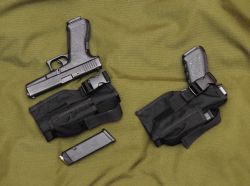 The Glock pistol began manufacture in Austria in 1983 by Glock GmbH. Today there is a Glock manufacturing facility in Smyrna, Ga which opened in 2009. There have been several versions of the Glock pistols known as “Generations’ or Gen 2-3 and now the Gen-4 brought out in 2010. Each version incorporated new upgrades, or design changes or so-called improvements. The Gen-4’s main upgrade was options in the configuration of the grip. Such “changes” are in the eyes of the beholder and user. Many Gen-4 buyers have sold them going back to the Gen-3 versions.
The Glock pistol began manufacture in Austria in 1983 by Glock GmbH. Today there is a Glock manufacturing facility in Smyrna, Ga which opened in 2009. There have been several versions of the Glock pistols known as “Generations’ or Gen 2-3 and now the Gen-4 brought out in 2010. Each version incorporated new upgrades, or design changes or so-called improvements. The Gen-4’s main upgrade was options in the configuration of the grip. Such “changes” are in the eyes of the beholder and user. Many Gen-4 buyers have sold them going back to the Gen-3 versions.
The primary Glock chambered for the .45 ACP is their Model 21. It is the full sized model with a 4.49 inch barrel. There is a shorter, compact version, too, the Model 30. The Model 21 weighs in at 29 ounces. That is 1.8+ pounds. It is a sizable pistol not fitting all hands well. What made the Glock pistol design famous is their ubiquitous polymer frame. The barrels are steel as is the slide and all internal springs. The sights are fixed, though aftermarket sights offer other options such as a Tru-Glo night sight. The Glock pistol is comprised of only 35 parts for reliability and simplicity. This is why many law enforcement agencies use them.
Also Read: Smith & Wesson Governor
Glock pistols are double-action, meaning with a round in the chamber, the shooter has only to pull the trigger. The firearm will fire, eject the spent cartridge and reload a fresh round from the magazine ready to be fired again. Factory magazines can hold either 10 or 13 rounds.
When I work the gun shows in my area, I work for a certified Glock armorer company called GlockPro of Mississippi. They sell only trigger kits, aftermarket sight kits, springs, do-dads, and official factory accessories. They do all the parts change outs and fitting at the show while the customer walks around the show. I see a lot of Glocks used by a lot of pistol owners. Glock shooters don’t really criticize the pistol, but they seem to rush to us for a lighter trigger kit after just having bought a brand new pistol in the factory box. They also favor one of the three sight enhancement kit versions we sell and install. Night sights are a primary choice.
Also Read: Survival Shotgun Selection
Glocks shoot every time you pull the trigger, well for the most part. They are very reliable guns if the shooter knows how to shoot it. A strong grip is paramount in the pistol’s performance. Limp-wristing this pistol will cause it to stovepipe. Parts do break on the Glock and some come from the factory with “issues.” I hear repeatedly that many Glock owners have returned their guns to the factory in Georgia for “adjustments.” It can happen with anything.
If I am asked I will be honest. I do not personally like the Glock. I have owned them, but the slippery plastic grip simply does not work for me and I have a big mitt. The grip angle and surface are just not to my personal liking. For me, the Glock is just ugly. It is functional, but not awe inspiring to look at, but again that is a personal choice and does not distract from the gun’s use. If I bought another Glock (which I doubt) I would go with a 9mm. The .40 Cal is a solution to a non-existent problem. So is the SIG round in my opinion.
The Battlefield 1911
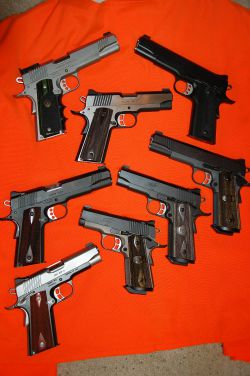 If you want a good historical read on a handgun, look up the background of the original 1911 from conception until the current modern versions of today. The classic 1911 pistol is likely the most prolifically copied handgun design of all time. I suspect there are easily as many as 100+ manufacturers’ 1911 models being produced today. The original refined 1911 model was designed for use as the primary sidearm for WWII though earlier models were produced and used earlier for military applications. They were used mostly by officers, pilots, and higher ranking medical personnel. Some line troops may have had access to them. After the war they were widely used by returning troops and later by civilians in large numbers.
If you want a good historical read on a handgun, look up the background of the original 1911 from conception until the current modern versions of today. The classic 1911 pistol is likely the most prolifically copied handgun design of all time. I suspect there are easily as many as 100+ manufacturers’ 1911 models being produced today. The original refined 1911 model was designed for use as the primary sidearm for WWII though earlier models were produced and used earlier for military applications. They were used mostly by officers, pilots, and higher ranking medical personnel. Some line troops may have had access to them. After the war they were widely used by returning troops and later by civilians in large numbers.
The current Colt and the many copies of the 1911/1991 versions are primarily chambered for the .45 ACP though they have been and are available in other calibers such as the 9mm and the .38 Super as well as the .22 rimfire mostly in conversion kits. The basic 1911 is an all steel pistol, blued finish, bright or matte with other options including stainless now and the old Parkerized finish. Many other custom materials, coatings and finishes are offered by manufacturers. The 1911 comes with a standard 5-inch barrel and slide, 7-shot magazine, slide lock, left hand side slide safety lock, grip safety and wood, plastic, or synthetic grips panels.
Also Read: Smith & Wesson Bodyguard .380
The 1911 is a single action pistol. This means the slide has to be racked or “cocked” back to the locked position which also cocks the hammer. Upon release of the slide by the slide release lever, the slide moves forward stripping a cartridge round out of the top of the magazine and chambering it. This loads the pistol into firing ready. This is all over simplified. The pistol is then ready to be fired with a firm grip to actuate the grip safety if the side safety is off. Pulling the trigger fires the round, cycles the slide back, recocking the hammer making it ready to be released again to strip another round.
At this point too, the pistol’s side safety can be put on and the hammer lowered or left in the “cocked and locked” condition. Again familiarization with the 1911 action and sequence is necessary for safe and proficient operation. It is easier to do and learn than to describe in writing.
Summary Commentary
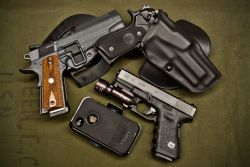 As you can see, these two pistols are completely different designs primarily as either single or double action mechanisms. Preppers will need to decide which system will work better or easier for them. I naturally recommend that potential buyers check out both pistols thoroughly, handle them and then shoot them both before purchasing one or more.
As you can see, these two pistols are completely different designs primarily as either single or double action mechanisms. Preppers will need to decide which system will work better or easier for them. I naturally recommend that potential buyers check out both pistols thoroughly, handle them and then shoot them both before purchasing one or more.
For solo preppers, teams or tribes, I suggest picking one or the other and not to mix types for the entire group. I strongly advocate standardization of pistols, calibers, magazines, holsters, cleaning gear, and other gear related to SHTF self-defensive, protective or offensive weapons. If you select the .45 ACP as your heavy pistol choice, pick one of these two.





